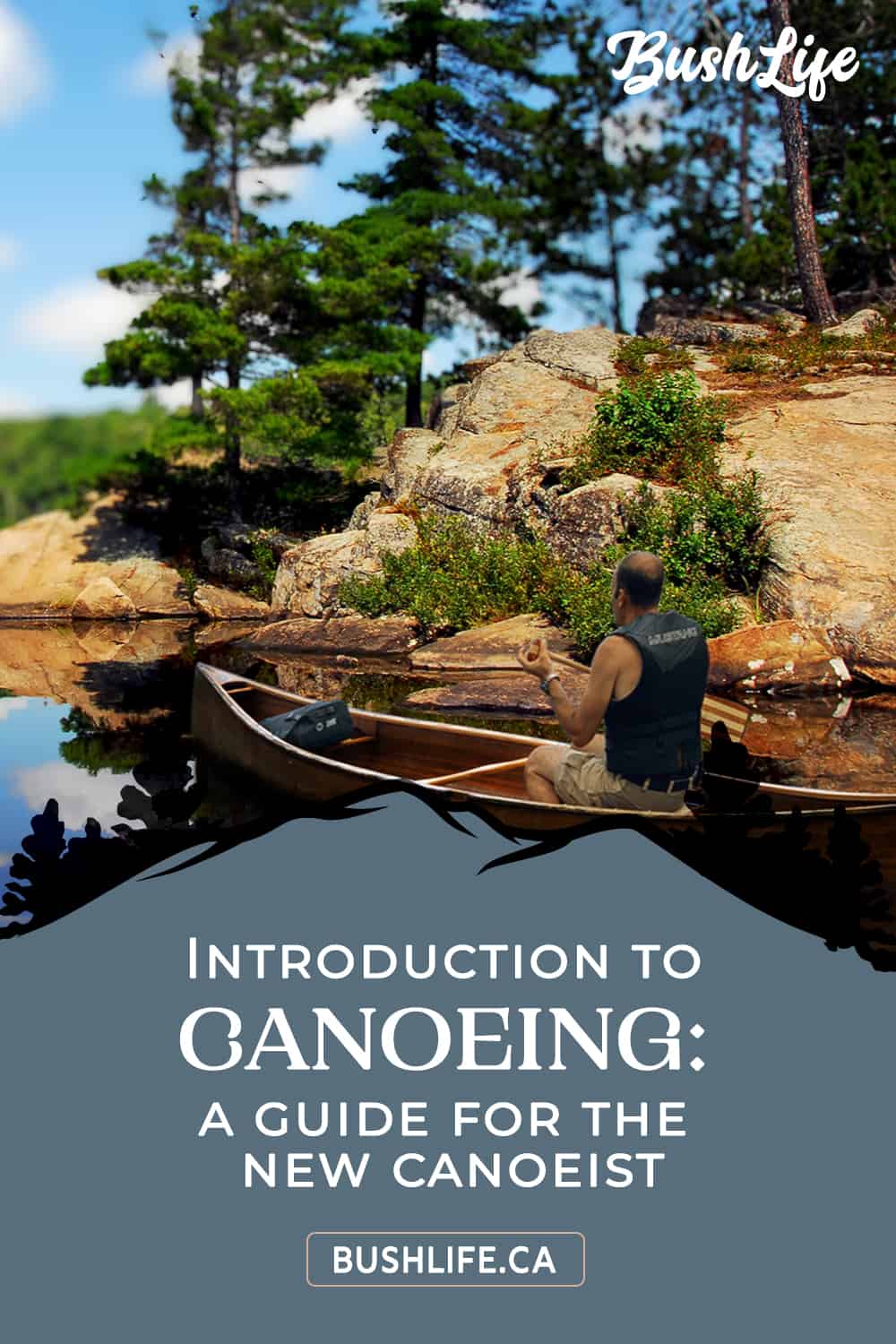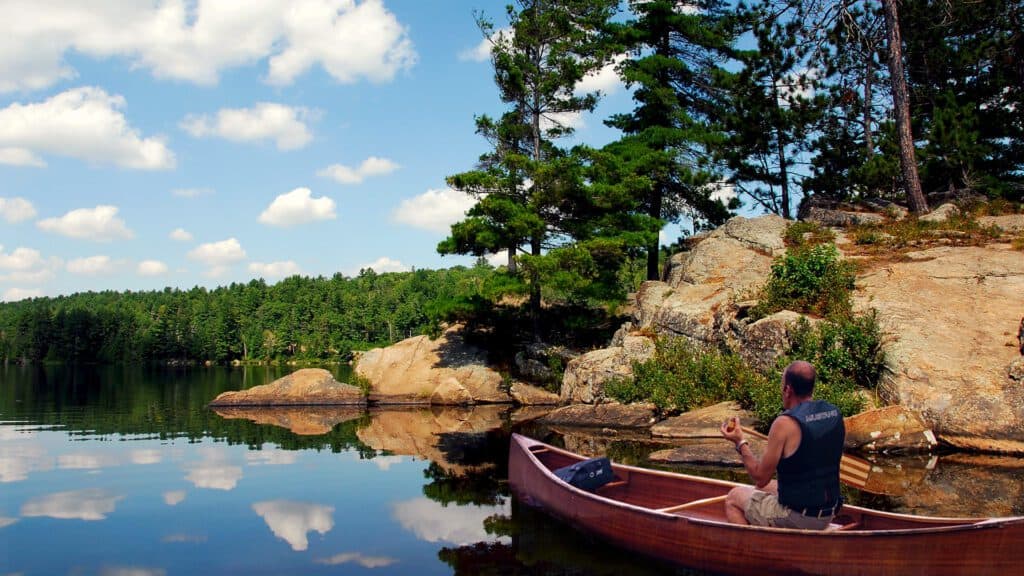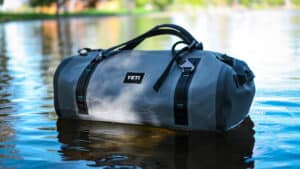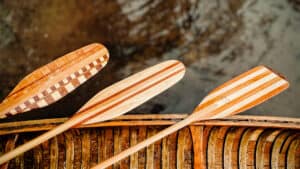On a fall morning, most lakes and rivers are kind of magical – they steam beautifully against the cold morning air. Calmer morning winds provide a mirror backdrop for the sky and the tree canopy shows its amazing colours. There is no better way to enjoy these kinds of days than with a morning canoe paddle. As the cold comes in more and more, these kinds of days are running out so let’s get through an introduction to canoeing so you can get going quickly. Or at least get ready for next spring.
Discloure: Posts may contain affiliate links. Purchases made through our links result in a small commission to us at no charge to you. We only recommend products that meet our brand standards based on testing and first hand use by our authors.
- Canoe Construction
- What Are Canoes Made From?
- What Canoe Do I Use?
- Canoe Shapes
- What Types of Canoe Paddles Are There?
- The “J” Stroke is The Most Important Part of Anyone’s Introduction to Canoeing
- How To Manoeuve a Canoe
- Paddling 2 Person
- An Introduction to Canoeing Can’t Be Done Without the Accessories!
- Waterproof Duffels
- Yes, the Boat Safety Kit
- Canada and the Iconic Canoe
- Introduction to Canoeing – Conclusion
Canoe Construction
A good start to this post would be to address the different materials canoes are made of and their effect on weight.
When we bought our cottage, it came with a giant yellow canoe that was hanging off the ceiling in the garage collecting dust. This was all fine and dandy until I had to move it out of the way… I quickly realized somehow, someone managed to get it up there and they probably thought twice about ever pulling it down again as it weighs so much. This can be a good and bad thing as with weight comes stability.
The thing is, I live on a lake and can drag just about any canoe to the water and leave it there for convenient use. But for anyone who needs to carry it on the roof of a car or anyone tripping where a portage is required, you certainly don’t want one of these beasts. That’s because it’s an old-school fibreglass model. Mine certainly feels like a 90-pounder, so I use it confidently on the lake and leave it at home when it’s time to canoe elsewhere.
What Are Canoes Made From?
As an intro to canoeing, let’s look at what canoes are made of and which canoe would be best for you.
Fibreglass
Fibreglass is what boats are made of, and it was a legendary material when it first came out. Many, many moons ago, a salesman once gave my grandfather an axe to smack the hull of a boat. It was his quest to prove how solid it was. He was certainly right about its strength, as the axe bounced right back.
On a canoe, fibreglass would generally be an inexpensive to mid-grade model. These budget canoes come at the price of weight. 70-80 lbs is my best guess for a typical fibreglass model.
Polyethylene (Plastic)
These are very tough models of canoe, and very heavy. Typically, 80 lbs. Similar to fibreglass, polyethylene canoes are durable and require little maintenance but they are not something to be portaging in the backwoods. These canoes are great for people who own land on water and intend to canoe locally.
Royalex
Back in the day, anyone doing white water rafting was after Royalex. It was an amazing product of extreme durability and for that reason, it deserves a mention.
As of 2013, they stopped manufacturing the “Royalex” material, but if a decent one showed up on the used market, I’d say it would be a game for anyone ever considering white water adventures. We are talking around 70 lbs for 16′ of canoe.
Kevlar
Kevlar is light, really light! 40-50 lbs for a 16′ model. Thanks to the strength of its fibres, fewer are required to make a strong kevlar canoe. Maintenance isn’t substantial either, however, Kevlar is much more difficult to repair. Kevlar is also a faster variety of canoe. All sounds great, what’s the catch? Price. Kevlar is far more expensive than fibreglass or plastic.
Aluminum
Aluminum seems to get a bad rap, and I don’t know why. My neighbour has one and he was kind enough to lend it to me. I found it to be super light, and unlike the stereotype that they are loud, it wasn’t bad at all.
I also found it to be stable and strong despite the lack of weight. While not pretty, not the fastest nor a typical canoe for “canoeing”, I would certainly use one for fishing or hunting, and I find aluminum to be very utilitarian.
It is also durable, requires little maintenance and is unaffected by UV light. The one downside is it gets hot under the sun, which is easily solved by throwing a towel or chair pad under your backside.
Cedar Strip

Here you have the Mercedes or Cadillac, so to speak of canoes. I’ve also had the pleasure of borrowing one from another neighbour, which led me to get my own pictured above. In my mind, there is nothing more relaxing than going down a quiet lake or river in a cedar strip. It’s almost like driving a classic car, but without lacking a single amenity or quality in the process.
These canoes are fairly light, quiet, responsive and fast. They are also very expensive as they are extremely labour-intensive to make. Being wooden and exposed to the elements, you guessed it, they also require a lot (and the most) amount of maintenance of all canoes.
A cedar strip is not only a big commitment of finances and time (maintenance), but also emotion, as it’s a piece that can be proudly paddled and handed down to the next generation.
What Canoe Do I Use?
I have a Bever brand from Sweden. It’s that 16′ flat-bottomed fibreglass I mentioned earlier. This canoe is heavy and VERY stable. It’s the most stable canoe I have ever used, which is why I keep it. It’s awesome for going down the lake, stable for beginners and it cuts through waves with ease.
My other canoe is a 16′ Swift Kevlar and I love it. I had the pleasure of buying it this year, which believe me, was a nightmare as is anything else during COVID. I bought a 19-year-old model that was in better shape than many canoes a year old, meaning it didn’t get much use.
It still cost a fortune and I had to drive an hour and a half one way to pick it up. Why all the trouble? This canoe opens many doors as it responds better to different strokes and is very transport and portage-friendly.
Further Reading: Transporting a Canoe, the Right Way
My canoes are opposites and on purpose, as they provide the right options for whatever required use a certain outing presents. And then, of course, there’s my favourite, the cedar strip.
Canoe Shapes
So, let’s talk about rockers. Rocker is the amount of curvature (front and back) a canoe has.
Flat bottoms are excellent for travelling in a straight line such as going across a lake. They will track better and have more speed.
Curved bottoms are much better for manoeuvring, the more curvature, the more easily the canoe will want to turn. This, of course, is at the expense of speed.
As to the bottom, there are some shapes here as well. By bottom, I mean from the keel upwards and around the sides of the canoe.
Flat bottoms are more stable for entry/exit but will roll over more easily while paddling. Rounded bottoms are the exact opposite and are faster and more manoeuvrable. In other words, novices are better off with flatter bottoms.
Other shapes like tumblehome are similar to a flat bottom but the sides curve in more facilitating easier reach with a paddle while maintaining load capacity. V-shapes are good for lakes and straight lines, but not so good for rivers.
Let’s go back to my canoes for comparison. The fibreglass is flat and super stable. The Kevlar is very rounded and far more difficult to get in and out of. I also find it generally a lot tippier while paddling, however, it will turn on a dime. For fishing, guests, etc. we use fiberglass. For a more “paddling” type of experience, out comes the Kevlar.
What Types of Canoe Paddles Are There?
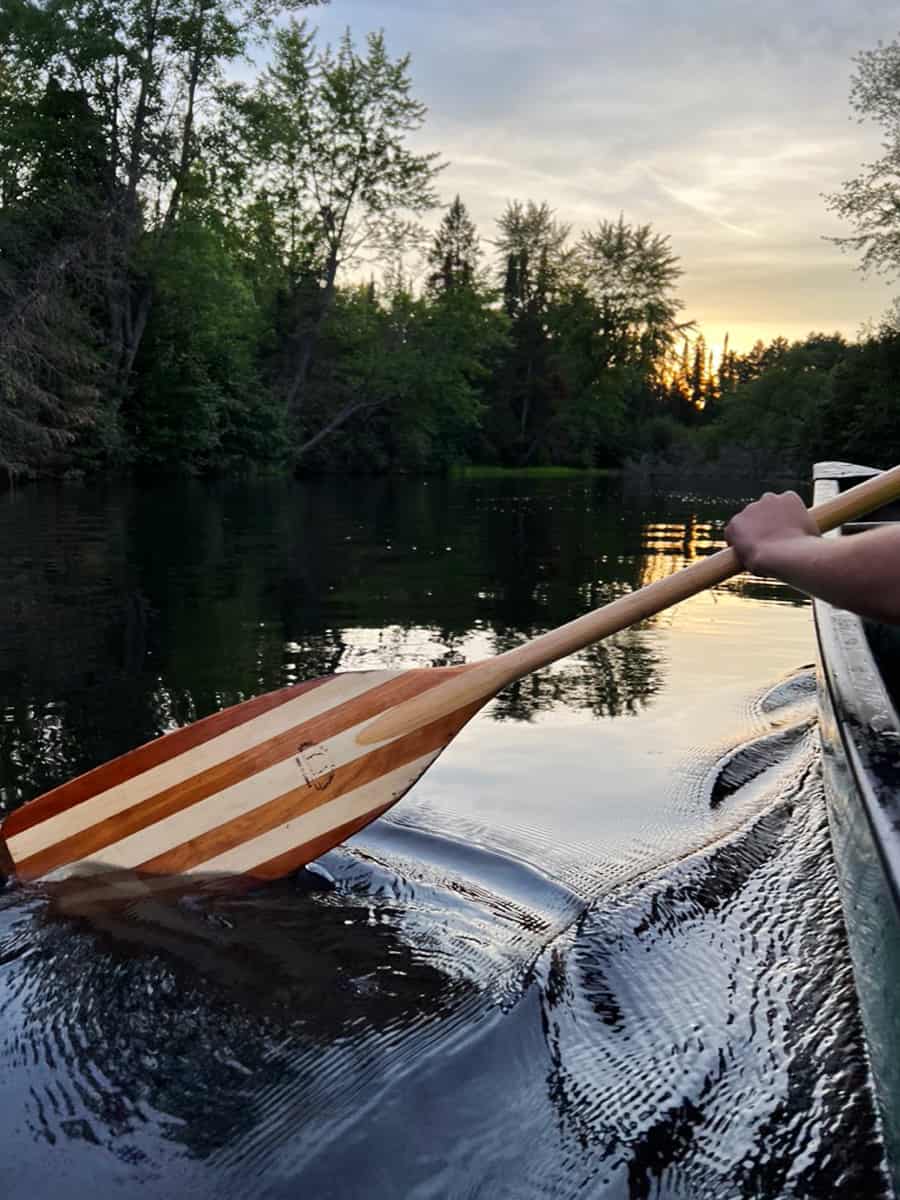
Yes, canoe paddles make a difference, and a huge one at that. The wider paddles will move more water and accelerate the canoe faster. This is great for racing but will cause fatigue quickly.
Tall and narrow paddles are more for trips. Each stroke is much easier, fatigue is put on hold but the canoe will not respond as well. I like to be right down the middle so to speak, and average out the best of both worlds. I also splurged a bit on a handmade wooden paddle so at least when you go by, you get a nice complement by just about anyone close enough to see the work of art in your hands.
Don’t forget to get a paddle that is the right size and fit for you. Check out our canoe paddle sizing guide to learn how to find the best paddle for you.
Further Reading: Canoe Paddle Sizing: A Beginner’s Guide
The “J” Stroke is The Most Important Part of Anyone’s Introduction to Canoeing
In a how-to canoe for beginners, we cannot move on without mentioning the infamous J stroke! Now that we have the canoe and paddle sorted out, it’s time to use it.
There is however one big problem. With each paddle on the right of the canoe, the canoe wants to turn left. With each paddle on the left, well of course the canoe wants to turn right. It’s so easy to spot the newbie from the not-so-newbie just by watching someone paddle.
To go in a straight line, the beginner will alternate sides they paddle on. I hesitate to say, intermediate, pro, etc. as the “not-so-newbie” is the one that learns a stroke and goes forward in a straight line without having to switch sides.
And, here comes the J stroke. The path of the paddle going through the water needs to form the shape of a J. The paddle curving away from the boat in that J shape will compensate for having thrust on one side of the boat and the canoe will amazingly go straight! Only when paddling the right side, remember you need to flip your J like this: Ⴑ
There are other strokes at our avail, but let’s stick with the J stroke for now. It would be criminal in an introduction to canoeing to not bring it up. It is a very easy skill to learn, and you can overcome the most frustrating part of paddling with this one little trick.
How To Manoeuve a Canoe
There are times we need to go sideways, and yes, a canoe can go sideways. Times we need to turn in position. Other times we need to quickly pull off to the side, such as avoiding waterfalls on rivers, etc.
As much as I love writing and this is a blog, there are those moments when it’s far more suitable to cover certain topics with a video. If you are new to canoeing or want to improve your paddling, this video will single-handedly propel your skills to a whole new level. It’s not my video, it’s one of the very tools that taught me.
This video is from, none other than Bill Mason, a legendary Canadian filmmaker and author of canoeing books. I’ve embedded it below from the National Film Board’s YouTube channel. If you are serious about canoeing, this less than 28-minute video will make all the difference in the world for your skills.
Paddling 2 Person
Even better, you’ll have someone to talk to! And you should watch this one:
An Introduction to Canoeing Can’t Be Done Without the Accessories!
So, here’s a funny story. A friend, who is a hunting guide was on a hunt and once saw a person stand up in a canoe. This generally is not a good idea. The hunter then proceeded to pull out a 12 gauge shotgun and blast away at some birds, only to find himself flipped over backwards straight into the water. He didn’t read an Introduction to Canoeing:)
While this is funny, at the wrong place and a colder time, this could also mean a survival situation. If you haven’t already read Backpack Gear Load Out, now would be a good time. The only difference here is it’s time to change the actual pack itself – for a waterproof variety.
Let’s take a look at some canoeing gear that a beginner canoeist should invest in.
Waterproof Duffels
Yeti Panga 75
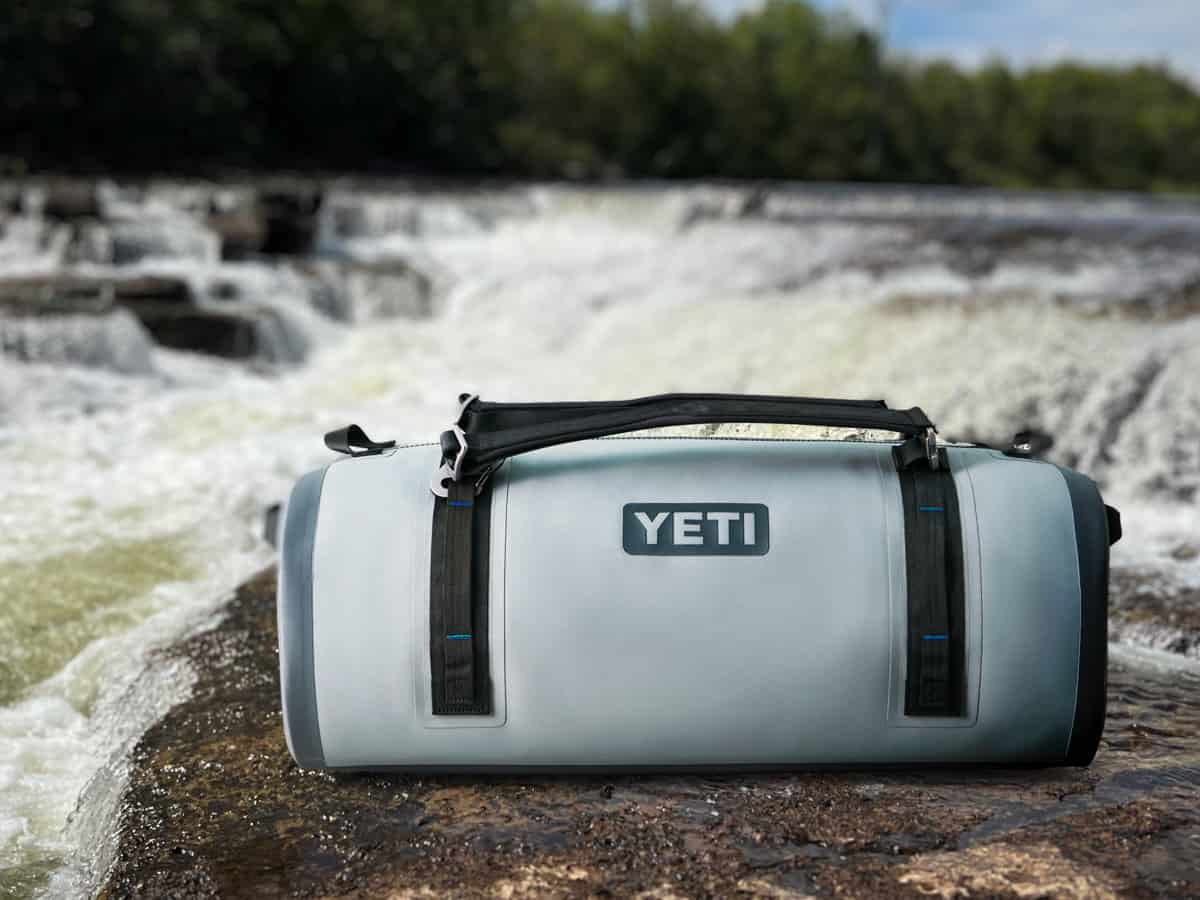
The Yeti Panga 75 is my go-to bag for longer trips. At 75 litres, as the model implies, there is plenty of room to carry ample gear. You won’t find pockets here which can be a pain but careful packing will get the job done right. The bottom line is the bag is watertight – which means it not only keeps your gear dry, it floats. Good gear costs money and it’s worth considering a waterproof duffel to protect your investment.
Further Reading: YETI Panga 75 Waterproof Duffel Review
Mustang Survival Greenwater 35
My other waterproof bag is the Mustang Survival Greenwater 35. As its name implies, it’s a convenient 35 litres. Perfect for short trips! My only complaint with this bag is it lacks a body. When you pick it up by the shoulder strap it bends a lot and doesn’t sit like a typical duffle. However, it does do its job perfectly in terms of protecting my gear, and it just really fills that size well.
Further Reading: Waterproof Duffel Bag: Is The Startling Cost Really Worth It?
Yes, the Boat Safety Kit
You can have a nice quiet paddle or you can have the law writing you tickets. With paddle power, I don’t think you’ll outrun the police on this one:) Just do the right thing and buy the boater’s safety kit. It’s for your good anyway.
The Fox 40 Boat Essentials Kit has a heaving line to toss to an overboard passenger, a whistle and a flashlight. The container doubles as a bailing bucket. This safety kit needs to be with you at all times as well as a life jacket for each paddler.
If you are not going deeper into the backcountry, you won’t need everything in my survival kit. I do, however, suggest always carrying some water, snacks, sunscreen, bug spray and a hat. Don’t forget to get a waterproof pouch to keep your phone dry. There are several purpose-built wet pouches out there. And, always dress and carry appropriate clothing for the time of year. Many people don’t realize that it’s almost always colder on water than on land, so if in doubt, be extra prepared.
Canada and the Iconic Canoe
I once read that the United States is a country known for its horses. Back in the day, the way to travel the vast land was by horse until the railways came in. In Canada, the vehicle of choice was always the canoe. Sadly, I didn’t know this until I wrote the introduction to canoeing.
With over 2 million lakes and 8,500 named rivers, Canada is the nation of water! I also read and going by memory, that one can cross the country from coast to coast by canoe.
The longest portage on this very trip would be around 20 km. That’s pretty remarkable considering a coast-to-coast distance is anywhere from 5,500 to 7,200 km! So yes, there is nothing more historic or iconic in Canada than the canoe. It’s a tradition that goes back to our indigenous peoples and their birch bark canoes.
Introduction to Canoeing – Conclusion
Truth be told, if something didn’t have a motor I had no interest in it. Somewhere along the way, I’ve come to appreciate that it’s nice to be close to the water, to be quiet, to hear the sounds of nature and to see the shores from a different perspective.
Going from point A to B isn’t always about getting to B. You can see and hear things along the way that you would never have noticed when you are flying by in a motorboat. It’s what inspired me to write an introduction to canoeing.
So, do yourself a favour, grab a canoe and get out there. Perhaps, you can’t even truly call yourself a Canadian until you fall off a canoe at least once in your life.
Enjoyed this Intro to Canoeing post? Subscribe to our newsletter for more tips and updates!
Bookmark this post on Pinterest for future reference!
